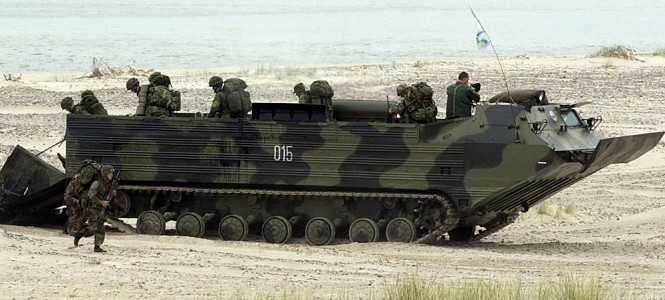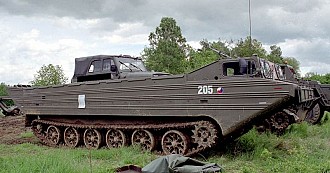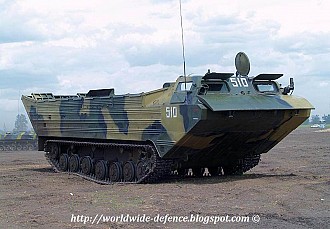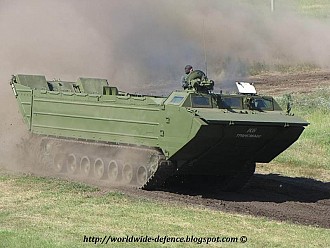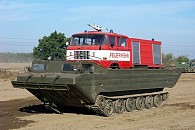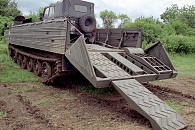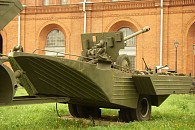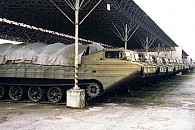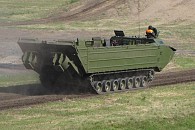Combat vehicles / Logistics vehicles / PTS
PTS
General Facts
- TYPE
All-terrain vehicle - ORIGIN
 USSR
USSR - NICKNAMES
PTS-10 (PTS-M in Czechoslovak service) - DESIGNED
Early 1960's - DESIGNER
Krasnoyarsk shipbuilding yard - PRODUCTION
1965 - 1980's (PTS, PTS-M)
1985 - present (PTS-2 and newer) - PRODUCERS
 Russia - KBTM Omsk (PTS-4)
Russia - KBTM Omsk (PTS-4)
 USSR
USSR - QUANTITY
Unknown - UNIT COST
Unknown - CHARACTERISTICS
 Good performance in water
Good performance in water
 Good cargo capacity
Good cargo capacity
 Average mobility on land
Average mobility on land
 Large and bulky vehicle
Large and bulky vehicle
Introduction
The PTS is an amphibious vehicle of Soviet origin. It was developed in the early 1960's as a replacement for the earlier K-61 amphibious vehicle. The name PTS stands for Plavayushchij Transportyer Sryednyj, which is Russian for medium amphibious vehicle. Although the PTS may also transport cargo on land its performance is much better in the water. In the mid 1980's the more capable PTS-2 was introduced. The PTS-4 is the current production model.
Layout
The PTS is based on the chassis of the ATS-59 artillery tractor and has a boat like hull. The crew compartment is located at the front and provides seating for the driver and commander. The rest of the vehicle is the cargo area which is loaded using the ramp at the rear. The engine is located in the middle and powers both the tracks and the two propellers. The PTS-2 is a later development with a similar layout as the original PTS. The PTS-2 is based on the MT-T chassis which has the running gear of the T-64 main battle tank. The PTS-2 is a larger vehicle with a more powerful engine which results in better payload and mobility. The PTS-4 is the latest production model and is based on the T-80 main battle tank chassis and is fitted with a diesel engine. Otherwise it is very similar to the PTS-2.
Cargo capacity
The PTS may carry 5 t of cargo on land and 10 t in the water. The PTS-2 has a larger cargo area and may transport up to 12 t. Although the carry capacity is lower on land the full capacity may be used for up to 3 km in order to reach the water. The cargo area is large enough to carry a 5 t truck, 70 troops or 12 stretchers. Both vehicles may also use the PKP floating trailer which allows them to transport a prime mover and artillery piece in one ferry. The PTS-4 may carry up to 18 t in the water.
Mobility
The PTS is fully amphibious and is better suited at traversing water than most amphibious armored vehicles, although it is difficult to steer. The tracked chassis provides a good all terrain performance on land albeit at limited speeds. The V-54 diesel engine produces 350 hp and allows the PTS to travel at 42 km/h on land and at 11 km/h in the water. The PTS-2 has a 720 hp diesel engine derived from the engine used on the T-72 main battle tank. This provides it with a road speed of 60 km/h and 12 km/h in the water. The increased mobility of the PTS-2 makes it more suitable for use in salt water. The PTS-4 has a 840 hp diesel engine that provides a 60 km/h speed on land an 15 km/h in the water
Users
The primary user of the PTS and PTS-2 was the USSR. Nowadays Russia remains the major user. Many vehicles were exported to Warsaw Pact nations and various Soviet allies around the world. Most PTS have been retired or replaced by the newer PTS-2, but some remain in service today. A limited number of PTS-4 is reported to be in Russian service.
PTS
The PTS is an amphibious vehicle based on the ATS-59 chassis. The original PTS was quickly replaced in production by the improved PTS-M, which was often referred to as PTS as well.
PTS: Original vehicle with A-712P 300 hp engine.
PTS-M: Improved PTS with V-54P 350 hp engine.
| Type | Amphibious vehicle |
|---|---|
| Crew | 2 + 70 (driver, assistant, 70 infantry) |
| Length | 11.4 m |
| Width | 3.3 m |
| Height | 2.65 m |
| Ground clearance | 0.4 m |
| Weight | 18 t empty, 28 t max load |
| Ground pressure | 0.38 kg/cm2 empty, 0.58 kg/cm2 max load |
| Wheelbase | Tracked chassis, 6 roadwheels, drive sprocket front, idler rear, 5.63 m length, 0.48 m width, 2.8 m track |
| Turn radius | ? |
| Engine | A-712P V12 diesel, 300 hp |
| Power ratio | 10.8 hp/t |
|---|---|
| Transmission | ? |
| Speed | 40 km/h on road, 10 km/h in water |
| Fuel | ? |
| Range | 300 km on road, 10 km in water |
| Wall | 0.65 m |
| Trench | 2.5 m |
| Gradient | 60% gradient unladen, 20% gradient laden |
| Fording | Amphibious |
| Armor | Steel |
| NBC equipment | Yes |
| Night vision | Yes |
|---|---|
| Smoke | No |
| Remarks | 7.9 x 2.6 m load area, 5 t cargo on land, 10 t cargo in water |
| Armament | - |
| Weapon1 | - |
| Weapon2 | - |
| Weapon3 | - |
| Weapon4 | - |
| Weapon5 | - |
| Weapon6 | - |
| Type | Amphibious vehicle |
|---|---|
| Crew | 2 + 70 (driver, assistant, 70 infantry) |
| Length | 11.43 m |
| Width | 3.3 m |
| Height | 2.65 m |
| Ground clearance | 0.4 m |
| Weight | 17.7 t empty, 27.7 t max load |
| Ground pressure | 0.38 kg/cm2 empty, 0.58 kg/cm2 max load |
| Wheelbase | Tracked chassis, 6 roadwheels, drive sprocket front, idler rear, 5.63 m length, 0.48 m width, 2.8 m track |
| Turn radius | ? |
| Engine | V-54P V12 diesel, 350 hp at 1.800 rpm |
| Power ratio | 12.6 hp/t |
|---|---|
| Transmission | ? |
| Speed | 42 km/h on road, 11 km/h in water |
| Fuel | 705 L |
| Range | 380 km on road, 12 km in water |
| Wall | 0.65 m |
| Trench | 2.5 m |
| Gradient | 60% gradient unladen, 20% gradient laden |
| Fording | Amphibious |
| Armor | Steel |
| NBC equipment | Yes |
| Night vision | Yes |
|---|---|
| Smoke | No |
| Remarks | 7.9 x 2.6 m load area, 5 t cargo on land, 10 t cargo in water |
| Armament | - |
| Weapon1 | - |
| Weapon2 | - |
| Weapon3 | - |
| Weapon4 | - |
| Weapon5 | - |
| Weapon6 | - |
PTS-2
The PTS-2 is an amphibious vehicle based on the MT-T chassis. The PTS-2 has a similar layout as the PTS but is larger and has a more powerful engine. This results in a better mobility on land and water and a larger cargo capacity. The front and sides of the cabin are sloped and a trim vane is added.
PTS-2: Original and most common version of the PTS-2.
PTS-3: Variant of PTS-2 with higher sides for better performance in choppy water.
- Specifications:
- PTS-2
| Type | Amphibious vehicle |
|---|---|
| Crew | 1 + 2 (driver, 2 passengers) |
| Length | 12 m |
| Width | 3.3 m |
| Height | 3.17 m |
| Ground clearance | ? |
| Weight | 24.4 t empty |
| Ground pressure | ? |
| Wheelbase | Tracked chassis, 7 roadwheels, drive sprocket front, idler rear |
| Turn radius | ? |
| Engine | V-64-4 V12 diesel, 710 hp |
| Power ratio | ? |
|---|---|
| Transmission | ? |
| Speed | 60 km/h on road, 12 km/h in water |
| Fuel | ? |
| Range | 500 km on road |
| Wall | 0.65 m |
| Trench | 2.5 m |
| Gradient | 60% gradient, 30% slope |
| Fording | Amphibious |
| Armor | Steel |
| NBC equipment | Yes |
| Night vision | Yes |
|---|---|
| Smoke | No |
| Remarks | 8.3 x 2.6 m load area, 12 t cargo in water, 20 t cargo on land |
| Armament | - |
| Weapon1 | - |
| Weapon2 | - |
| Weapon3 | - |
| Weapon4 | - |
| Weapon5 | - |
| Weapon6 | - |
PTS-4
The PTS-4 is the latest version of the PTS series. It is based on a seven roadwheel chassis of the T-80 main battle tank. This is combined with the 840hp V-84MS diesel engine used in late model T-72 tanks.
PTS-4: A further improved PTS-2 based on T-72 and T-80 automotive components.
- Specifications:
- PTS-4
| Type | Amphibious vehicle |
|---|---|
| Crew | 1 + 2 (driver, 2 passengers) |
| Length | ? |
| Width | ? |
| Height | ? |
| Ground clearance | ? |
| Weight | 33 t max load |
| Ground pressure | ? |
| Wheelbase | Tracked chassis, 7 roadwheels, drive sprocket front, idler rear |
| Turn radius | ? |
| Engine | V-84MS V12 diesel engine, 840 hp at 2.000 rpm |
| Power ratio | 25.5 hp/t |
|---|---|
| Transmission | ? |
| Speed | 60 km/h on road, 15 km/h in water |
| Fuel | ? |
| Range | 600 km on road |
| Wall | ? |
| Trench | ? |
| Gradient | ? |
| Fording | Amphibious |
| Armor | Steel |
| NBC equipment | Yes |
| Night vision | Yes |
|---|---|
| Smoke | No |
| Remarks | 18 t cargo |
| Armament | 12.7mm NSVT heavy machine gun |
| Weapon1 | 12.7mm NSVT heavy machine gun on roof mount 400 rounds, 50 rounds ready to fire 360° manual traverse and elevation non-stabilized |
| Weapon2 | - |
| Weapon3 | - |
| Weapon4 | - |
| Weapon5 | - |
| Weapon6 | - |

